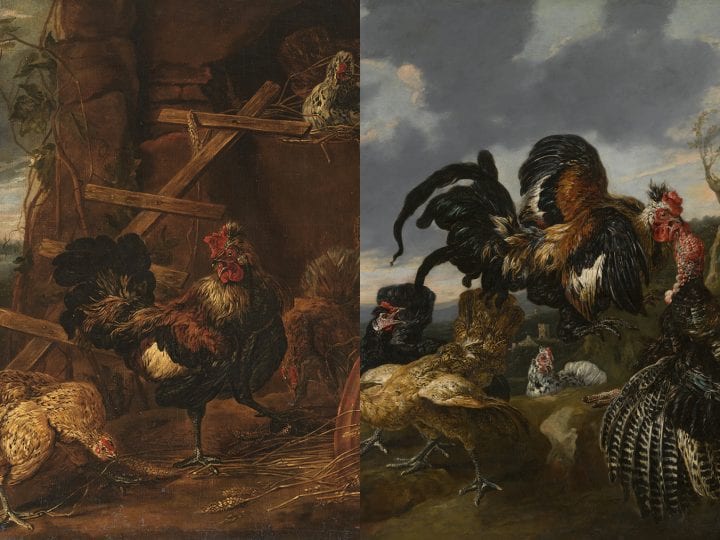Now better known as a hunting painter, the Antwerp animal specialist Joannes Fyt (1611–1661) also produced several depictions of Aesopic fables. A notable feature of Fyt’s fables is their attentiveness to the appearances and behaviors of animals and how they inhabit their environment. Focusing on two paintings by Fyt featuring poultry birds, this essay uses period fable books, a key discussion of fable by Erasmus, and zoopoetic theory to explore how these works address both the allegorical realm of fable and a tangible living world that was increasingly coming under investigation from natural history and related modes of inquiry.
Prior to the sixteenth century, Aesopic works in Latin and in vernacular languages enjoyed great popularity throughout the Low Countries.1 With the 1567 publication of Edewaerd de Dene’s (1505–1578) fable book called De Warachtige fabulen der dieren (The Truthful Fables of the Animals), the genre took on an even more important role in the region’s literary and visual culture.2 Containing 107 verse fables, each paired with an etching by the artist Marcus Gheeraerts (ca. 1520–ca. 1590), de Dene’s collection provided the impetus for a new mode of fable painting that was initiated by Rubens and significantly developed by Frans Snyders (1579–1657).3 Inspired by Snyders’s example, and sometimes under his direct tutelage, the genre was later taken up by younger painters, including Paul de Vos (ca. 1591–1578), Pieter Boel (1622–1674), and Jan van Kessel the Elder (1626–1679), who went on to turn it into one of the seventeenth century’s most innovative forms of animal depiction.4
My essay focuses on another Flemish artist whose fable paintings have received somewhat less attention: the animal specialist Joannes Fyt (1611–1661), whose most productive working years (ca. 1638–61) were spent in the city of Antwerp, within the Catholic, Habsburg-governed southern Netherlands. Returning to Antwerp in the late 1630s after spending the first decade of his career abroad, Fyt worked briefly in Snyders’s studio, where he would have had access to his older colleague’s two Aesopic fable books, before going on to forge a successful career through the rapid production of hunting scenes and still lifes with dead game.5 His engagement with fable is a departure from his regular output and amounts to just four pictures, two of which exist in variant copies.6 Prior scholarship on these works by Arnout Balis, Susan Koslow, and Lisanne Wepler has mainly examined how they adapt their literary and visual sources, the social context in which they were received, and their narrative strategies.7 By contrast, my discussion will concentrate on a distinctive pictorial feature of Fyt’s Aesopic works—the meticulous attention they pay to how animals move, gesticulate, sustain themselves, and inhabit their environment. By considering two paintings, The Cock and the Jewel (“Gallinero”) (fig. 1) and The Flemish Cock and the Turkey Cock (fig. 2), I will argue that this aspect of Fyt’s fable pictures would have been understood and appreciated in terms of the value placed on images that were thought to retain close contact with the “life” of the subjects they depict, in contexts spanning the modern divide between science and art, and between realism and modes of representation in which imagination is more central.
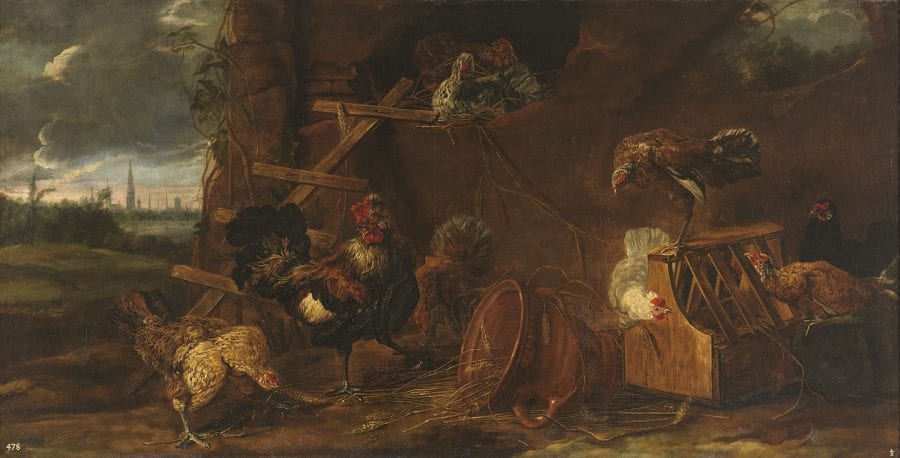

In examining the multiple forms of knowledge that these works address, my argument engages with recent scholarship that has stressed the deep entanglement of art, empirical investigation, and humanistic learning within early modern cultures of inquiry.8 Fable imagery, it is true, might seem an unlikely candidate for this line of analysis. Both the conventions of the fable genre, in which animals speak and act anthropomorphically, and its perpetuation of traditional wisdom place it at odds with a modern conception of knowledge that privileges original, objectively established claims. Yet, as William Ashworth, Paul Smith, Katherine Acheson, and others have shown, many of the fable images produced in northern Europe from the 1560s on have strong links to new ways of visualizing the natural world that were being developed at the same time in fields such as natural history and comparative anatomy.9 This could certainly extend to fable images featuring poultry birds; although Aristotle had characterized them as earth-bound creatures, being “dust bathing” rather than flighted, they were often discussed and depicted in works by early modern naturalists, for whom they are both aesthetically pleasing and fascinating in their phenotypic diversity.10 The Italian naturalist Ulisse Aldrovandi (1522–1605) remarked on their “natural splendour” and “incredible beauty,” while the English ornithologist John Ray (1627–1705) noted that “these birds . . . vary infinitely in colours” and differ markedly in size and head plumage.11
This essay’s critical stance also adopts a number of ideas from the strand of ecocriticism called zoopoetics. Originally developed by the literary scholar Aaron Moe to analyze the links between poetic forms and animal sounds and gestures, zoopoetics has since come to designate a range of theoretical approaches united by their framing of the animal as, first and foremost, an embodied, creative, active living being.12 Zoopoetics seeks to deconstruct the opposition between the real and the imagined (or “literary”) animal, showing how these are at once nonidentical and enmeshed in human thought.13 Among the existing varieties of ecocriticism, zoopoetics is particularly pertinent for my discussion because of this nonbinary stance, which challenges the impulse to move past the “surface” of the fable image, concerned with material nature, in order to get at something else: a meaning, a moral, a story, or a cache of factual data.14 In methodological terms, it also offers a sophisticated model of attentiveness that is helpful in clarifying how the works examined here move between “life” and the world of ideas.15 Zoopoetic attentiveness is alert not only to the animal’s appearance and other visible traits but also to how it inhabits and actively shapes its environment.16 In addition, it is strongly attuned to embodiment—that of the animal and of the human subject. As Eva Hoffmann and Kári Driscoll note, zoopoetics is “a poetics of the body, of the sudden reminder of one’s own corporeality and hence of one’s own animality.”17 This aspect of the theory, which modifies the strongly anti-anthropomorphising stance of earlier ecocritical approaches, offers a useful alternative to forms of interpretation that presume an underlying stress on human superiority or exceptionalism in the artwork.18
Throughout, it will be important to keep in mind that while fable is now seen as a genre that is mainly suitable for children, in Fyt’s period it commanded broader and more sophisticated appeal.19 Koslow has traced representations of fables by Snyders and artists in his circle to two noble collections in the southern Netherlands (those of the duke of Aerschot and Diego Mexía, marquis of Leganés), in which the works were probably displayed together in series. Flemish fable paintings are also recorded at two Spanish royal residences: ten images by Snyders and de Vos were used as overwindows and overdoors at the Torre de la Parada, a hunting lodge, and a 1701 inventory for the Buen Retiro, a rural palace, lists a further four by Snyders plus others by unnamed artists.20 While these works may well have been commissioned by their wealthy collectors, most fable pictures would have been created for the open market and cannot now be linked to specific named beholders. This seems to be the case with Fyt’s fables, and for this reason, my contextual analysis of his paintings draws mainly on sources like the Warachige fabulen that were relatively popular and/or were available in the vernacular or Latin, which was widely read among the more educated.21
Spotting the Fable in The Cock and the Jewel
Dated 1660 but unsigned, and currently owned by the Prado, my first example (fig. 1) has been credited to Fyt since it was first recorded as a “Gallinero con Gallinas” (poultry piece with chickens) in the 1746 inventory of the collection of Elisabeth Farnese (1692–1766), wife of Philip V of Spain, at the Royal Palace of La Granja de San Ildefonso.22 The attribution to Fyt has recently gained support with the appearance at auction of a smaller signed work that replicates a central section of the composition (fig. 3).23 Although the work is first documented in Spain, it was probably originally intended for the Flemish art market. The fact that it does not appear in Spanish royal inventories before 1746 suggests that it entered the country during the extensive campaign of picture buying undertaken by Philip and Elisabeth from the 1720s on, partly to decorate their new palace of La Granja, which was begun in 1721.24 In his lifetime, Fyt had few Spanish buyers; Antwerp was his primary market, and the appearance of the city’s skyline in the left background of the composition seems to address the picture to a local audience there.25
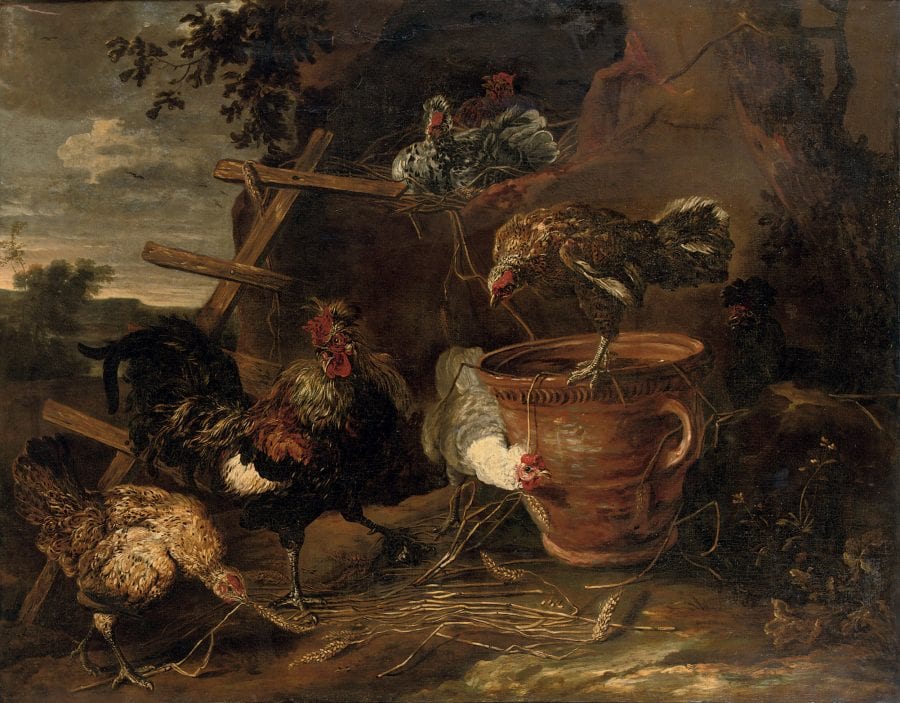
At almost two and a half meters wide, the Gallinero is one of Fyt’s largest paintings. It is thus initially surprising that it focuses on what appears to be a very humble scene. On a rough dirt track, ten birds stand, nest, or forage for food. The most prominent of these is the black and gold cock in the foreground. With one foot planted, he scratches with the other at a dark patch of soil strewn with grain stalks. On either side of the cock, their crouching stance underscoring his upright bearing, two hens bend their heads to the earth as if searching for food. Off to the right, beyond a toppled terracotta pot, five more hens encircle a wooden feed-box. A gold hen and a black hen at far right glance up and across at the brown hen perched on top of the feed-box. This bird peers down at a white hen who is nosing around the left-hand end of the box, craning her neck as if eager to catch a glimpse of her companions a short distance away. In a wall overlooking the site, two hens nest in an oval hollow. A ladder leads from their roost to the dirt track below.
A closer look at the painting reveals an important detail that broadens the interpretative response it demands. This is the jeweled ring beneath the cock’s leading foot (fig. 4), which signals an allusion to the Aesopic fable called The Cock and the Jewel.26 Upon finding a jewel (when named, usually a diamond, ruby, pearl, or a ring) while pecking in his straw for food, the cock declares that although it would be of great value to some people, it is of no use to him; he would prefer grains of corn or barley to eat. In the fable book tradition, this simple narrative is often interpreted as a condemnation of ignorance or materialism, failings embodied by the cock, who chooses transient bodily sustenance over the jewel, an object of lasting value.27 Unlike grain, however, a jewel cannot sustain life. Accordingly, alternative readings of the fable existed in which the pragmatism of the cock in preferring something useful over something showy, or his acuteness in noticing the jewel, are praised instead of censured. The Cock and the Jewel was evidently a popular fable in the Netherlands28 and may even have entered common language as a figure of speech, given its appearance in the 1603 Dutch translation of a conversation manual, where it demonstrates the differences between ignorant and learned people.29
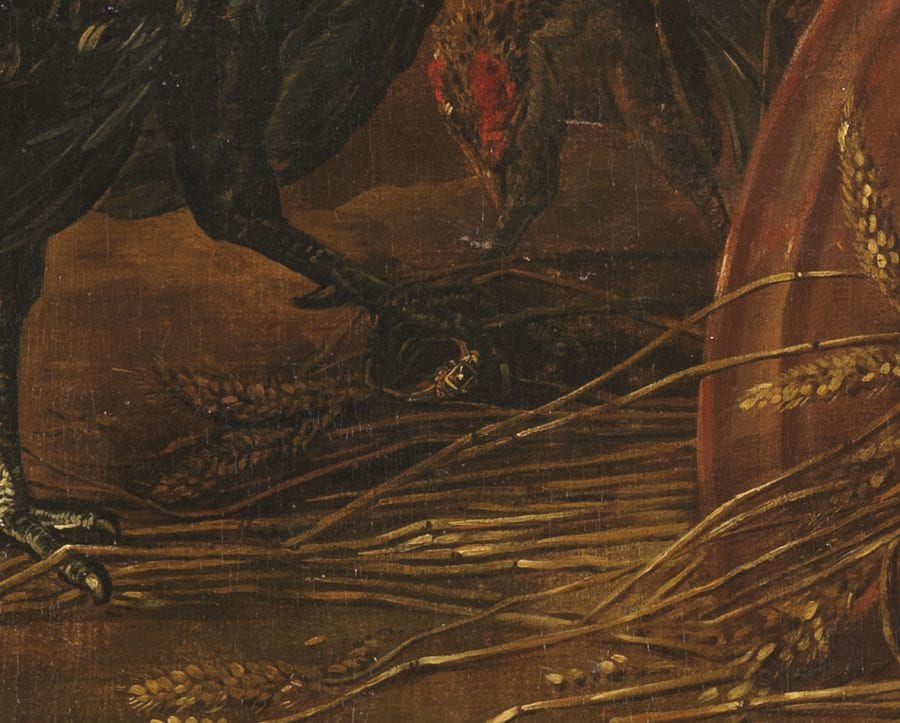
A broad range of interpretations of the fable can be found in the major vernacular fable collections available to Netherlandish readers in Fyt’s day. The moral accompanying the fable in the Warachtige fabulen specifically deprecates spiritual blindness. De Dene describes the cock’s attitude toward the jewel—“For that which one has no use for, one cares very little”—before noting its possible application to human behaviour:
Likewise those people who are of a worldly disposition and adrift, who instead of spirit choose things of flesh and blood, who scrape around in the earth most of the time, and are meticulous and grasping in their attitude to material goods; this is terrible and does a lot of harm—and quickly; they tread knowledge and wisdom under foot, and also put God entirely aside, leaving brightness lying on the side.30
A more multifaceted interpretation is offered in the Vorstelijcke Warande der Dieren, a popular 1617 adaptation of the Warachtige fabulen by the Dutch poet Joost van den Vondel (1587–1679). He initially follows de Dene in presenting the fable as a condemnation of those who value worldly things excessively—although here the cock, because he rejects the “pearl” (as the jewel is called in this text), represents spiritual wisdom rather than blindness. Immediately, however, the poet goes on to note that the pearl “is also the knowledge [konst] possessed by the wise and learned,” which the “unwitting cock” passes over:
O Crowned, wise bird! Would that you could teach your betters to despise and scorn their lascivious friskiness and costly flaunting. Thus will you convert men and yet reflect to them your ostentation and pride. The pearl is also the knowledge of the wise and the learned which the unwitting cock neglected and scorned: Superficiality is a jewel of no value if you lack inward humility.31
Notable here is the variety and incongruity of the significations proposed in just these two texts. The cock is seen as wise as well as ignorant, and in other fable books even figures as an embodiment of diligence, owing to his success in finding the ring.32
This more positive characterization of the animal was well known, appearing in emblematic and encyclopedic works as well as fable books. In the 1644 Dutch translation of Cesare Ripa’s influential emblem book, the Iconologia (1593), the cock appears in the emblem for “Diligenza.” The text characterizes the animal as “careful,” noting that “in [his] scraping and searching [he] shows great diligence, even when he finds nothing pleasing to him, distinguishing also the useless grains from the useful, which represent value and food for him.”33 Aldrovandi, whose works were known to Snyders (and thus very possibly also to his associate Fyt), mentions the animal’s connection to the careful, scrupulous merchant via his role as an attribute of Mercury, god of trade.34 He cites in support of this a proverb by the Latin poet Ausonius known as “The Rooster of Eucleo,” applicable to the person “who is accustomed to examine and investigate everything most diligently, not even neglecting the slightest dust until he has found that which he has searched for with the utmost care.”35
The complexity of the fable’s interpretative tradition is of interest when Fyt’s adaptation is placed in its art-historical context. There are only two major precedents for the painting, both linked to Snyders: an undated work by the older artist that was probably produced in the 1620s and is now in Aachen (fig. 5), and a workshop picture that was sold on the London art market in 2001 and was originally in the collection of Thomas, 1st Earl Coningsby (1656–1729) at Hampton Court, Herefordshire (fig. 6).36 Both closely follow the model supplied by Gheeraerts in his etching for the fable in the Warachtige fabulen (fig. 7).37 This is particularly true of the Aachen painting, in which, as in the print, the cock is depicted alone. In the workshop picture, additional interest is provided by the wide format and supplementary hens (ideas that Fyt may have borrowed for his treatment of the fable), but its depiction of the cock is, again, similar to that in the etching. Both these works are also immediately identifiable as fable paintings given the prominence they accord to the jewel: a red gem in a gold setting. A later adaptation of the fable, undated but probably produced at around the same time as or after Fyt’s (fig. 8), similarly situates the jewel in a discrete, uncluttered space where it is clearly visible.38
What emerges from these comparisons is that in Fyt’s Gallinero, more so than in adaptations of the fable by other artists, the fable coexists with a rich visual account of different avian behaviours and responses, not all of which can be linked directly to the narrative of The Cock and the Jewel or its usual moralizations. While the work would certainly have been legible as a fable painting, it is important not to gloss over the fact that it treats its subject in this rather expansive way, and that this produces a degree of interpretative uncertainty. On the one hand, the fable/ring is perfectly visible if this large painting is examined reasonably carefully, and both the familiarity of the fable and the circulation of fable books containing illustrations of The Cock and the Jewel may well have primed beholders to look for a jewel in a work of this kind. On the other hand, the allusion to fable is less explicit than in other versions. Significantly, no reference to it can be found in the eighteenth-century Spanish inventories in which the work was first recorded, although it was evidently still valued as a “poultry piece” that skillfully depicts avian life.
Viewing the painting through a zoopoetic lens cannot wholly resolve these tensions. However, it does allow us to see the different currents in the Gallinero as mutually reinforcing aspects of a praiseworthy attentiveness to nature that is attributed both to the artist and to the picture’s beholder. As Moe has argued, “an attentive disposition precedes imitation”; from a zoopoetic perspective, skilled imitation is not an exceptional faculty restricted to the artist, but it instead originates in the sensitive, vigilant response to the world that all living creatures, whether human or animal, display.39 Given that major themes of the fable as depicted in the Gallinero are the perception of value and the value of (visual) perceptiveness, it is thus significant that the work’s composition contains points of interest that reward the experience of viewing it carefully. These include the glittering eye visible between the bars of the feed-box that reveals the presence of an additional black hen in the right-hand group (fig. 1), and the individuated grain sheaves in the foreground, itemized so carefully that their stalks and ears can be counted. These bring the attentive painter and the attentive cock into alignment, presenting Fyt as an artist who, like the man in Ausonius’s proverb about the bird, is willing “to examine and investigate everything most diligently,” even the smallest ear of grain. In the case of the attentive beholder who notices the ring, a further parallel emerges between the event that drives the plot of the fable—the cock’s fortuitous spotting of the jewel—and the type of gaze that the painting encourages, in which noticing details is important as well as a source of pleasure and interest. Wittily revising the idea, mentioned in most textual versions of the fable, that earthly things should be rejected, the Gallinero asserts the value of skillful engagement with the material world, whether performed by the artist or an alert beholder.40
In the case of the animals, this attentive disposition extends to how they inhabit their environment. Consistent with premodern ideas about the need for human stewardship of nature, the painting implies that the birds’ existence has been enabled by benevolent human dominion.41 Readers familiar with the chapters in the works of naturalists such as Aldrovandi and Conrad Gessner on how to rear and house poultry, or the classical accounts they summarize, would have noted points of correspondence with the work. Grain, identified by Aldrovandi as the best possible food for the birds, is what they have been given to eat, and they have also been granted easy access to the nesting hole in line with his advice that outside the roost “little ladders should . . . be joined to the wall on which the birds may creep to their nightly rest.”42 In his description of the outdoor chicken run, Gessner notes that it should be open to the sun and sheltered from the wind and cold so as to keep the birds warm (conditions met by the screened space in the painting), and he recommends hollowing out small nests in a nearby wall to encourage egg laying.43 As mentioned previously, works by Aldrovandi were known in Snyders’s circle, and so it is quite possible that Fyt had gained knowledge, perhaps on a secondhand basis, about the ideas in these and similar texts relating to best practices in raising poultry. The crucial point, however, is that the painting could have been appreciated for its grasp of these down-to-earth matters as well as for the abstract ethical ideas linked to the fable that it conveys through their representation.
Naturalists also comment on another topic relevant to the themes of the picture: the visual and sensory faculties of poultry birds. The advanced perceptual powers of the typical cock are repeatedly identified as one of its defining traits. Aldrovandi notes his “exquisite sense of taste” which allows him to “judge on the spot any object . . . if only he can hold it in his mouth.”44 Also, the cock “possesses no small keenness of sight,” being able to make out predators from a distance, and even surpasses the eagle both in sharpness of vision and in having the ability to dedicate each eye to a separate task:
with only one eye always turned upwards [the cock] observes the birds of prey which are its most deadly enemies lest they unexpectedly snatch away either a chick or a hen or the rooster himself out of the chicken yard, while with the other eye he most diligently examines very small things.45
In contrast to later models of symbolism that propose an arbitrary relationship between referent and idea, here the visual acuity of the real animal is linked to (and implicitly validates) his association with the abstract concepts of diligence and vigilance.46
The Gallinero, similarly, moves between storytelling, allegory, and the lifelike depiction of real-world phenomena in a manner likely to have been appreciated by Fyt’s audience. In the discussion of the value of fable in Erasmus of Rotterdam’s influential rhetorical handbook De Utraque Verborum ac Rerum Copia (On Copia of Words and Ideas), better known as De Copia (1512), it is precisely this combination of creativity and keen attentiveness to the real world that is recommended.47 In the book’s main treatment of fable, Erasmus begins by noting its attractions for the reader (including its vividness and its capacity to provide a witty commentary on human behavior), before turning to the question of how to compose a fable:
Each person is perfectly at liberty to invent material [fables] of this sort, according to his subject, but if you are going to invent something appropriate, you need to be a person of lively imagination and you must have observed closely the nature of living creatures, and these are of infinite variety.48
Elsewhere in De Copia, Erasmus again remarks: “There are appropriate characteristics to be observed in fables, and this no one will be able to manage unless he has observed and studied the natures of living creatures,” following this up with several examples: “All this, and less well-known facts too,” he notes, “may be easily discovered in Aristotle, Pliny, and Aelian.”49 In Erasmus’s conception of fable, then, which resonates with a zoopoetic stance, the bodily and instinctual character of the animal should leave its trace in the text, rather than being expunged in order to turn the animal into a “character” unrelated to its real-world counterpart. The fable writer, moreover, should aim to capture the natures—not simply the contingent appearances or behaviors—of the creatures he is concerned with, relying if necessary on encyclopedic sources like Pliny’s Natural History to supplement his own experience.
These ideas might well have provided a way for contemporary beholders of Fyt’s work to comprehend his detailed attention to animals and their environment: as evidence of his ability to imbue Aesopic narratives with a sure grasp of living nature. This aspect of the work might even have been understood as a form of pictorial copia that wittily expands upon and embroiders around the main topic of the picture—the fable—to hint at what Erasmus calls the “infinite variety” of nature. The birds in the painting emerge as a vital point of intersection, being at once objects of study, sources of visual fascination, and beings which, though in a different way to the human, exhibit volition and agency.
Of Kin and Kind in The Flemish Cock and the Turkey Cock
Engagement with the diversity of avian life is also crucial to my second example, The Flemish Cock and the Turkey Cock, in which the variation between species underpins a fable about the ethical, political, and ecopolitical significance of sharing a dwelling place. Signed “Joannes Fyt” at lower left and dateable on stylistic grounds to the mid-1650s, only a single version of the painting, now in the Koninklijke Musea voor Schone Kunsten von België, Brussels (fig. 2), is known. Important precedents for the picture are the depictions of bird fighting that became popular in the Netherlands from the 1610s.50 The attraction of such works can in turn be connected to an interest in the sport of cock fighting,51 which despite being condemned by moralists was practiced by elites as well as commoners.52 Avian violence certainly seems to be one of the attractions of the painting discussed here. A large black and gold cock has leapt into the air in order to grasp the head of another bird with his beak. White highlights on the talons and spurs of the cock’s right leg call attention to their bony sharpness. The victim of the assault has been completely overpowered: he reels backward, two of his toes splaying out limply beneath his wing. At left, smaller birds flee the struggle or observe from a distance.
Though superficially similar to depictions of fighting cocks, the Brussels painting responds to a separate literary tradition. The victim of the cock’s attack is a turkey, identifiable by its nodular head and its snood—the red wattles beside its eyes. A new fable invented by de Dene, “De Vlaemsche ende Turcksche Haen” (The Flemish Cock and the Turkey/Turkish Cock), appeared for the first time in the Warachtige fabulen and was quickly incorporated into later adaptations of the book.53 In the fable, a turkey moves into the territory of a conceited cock, and his courteous behaviour immediately endears him to the local hens. Enraged at this incursion, the cock begins a campaign of violence against the turkey. When the turkey sees that his skirmishes with the cock are frightening the younger birds, he magnanimously decides to find a new home. In Fyt’s adaptation, careful attention to the gestures and appearances of individual birds—evident, for example, in the twisted poses of the scattering hens on the left, whose open mouths indicate that they are shrieking—showcases his knowledge of nature while also bringing de Dene’s fable to life. Dispensing with the rigid profile view of Gheeraerts’s original etching (fig. 9), Fyt allows the birds to dominate the pictorial space—especially the fighters, who are depicted in dynamic combat and situated in a barren landscape setting different from that seen in versions of the fable by other Antwerp painters (figs. 10–11). Fyt’s skill in depicting varied, lifelike animal bodies in lively movement is noted by Cornelis de Bie (1627–ca. 1715), a biographer of Dutch and Flemish artists, suggesting that these same qualities in the work would have been regarded positively in the artist’s day.54
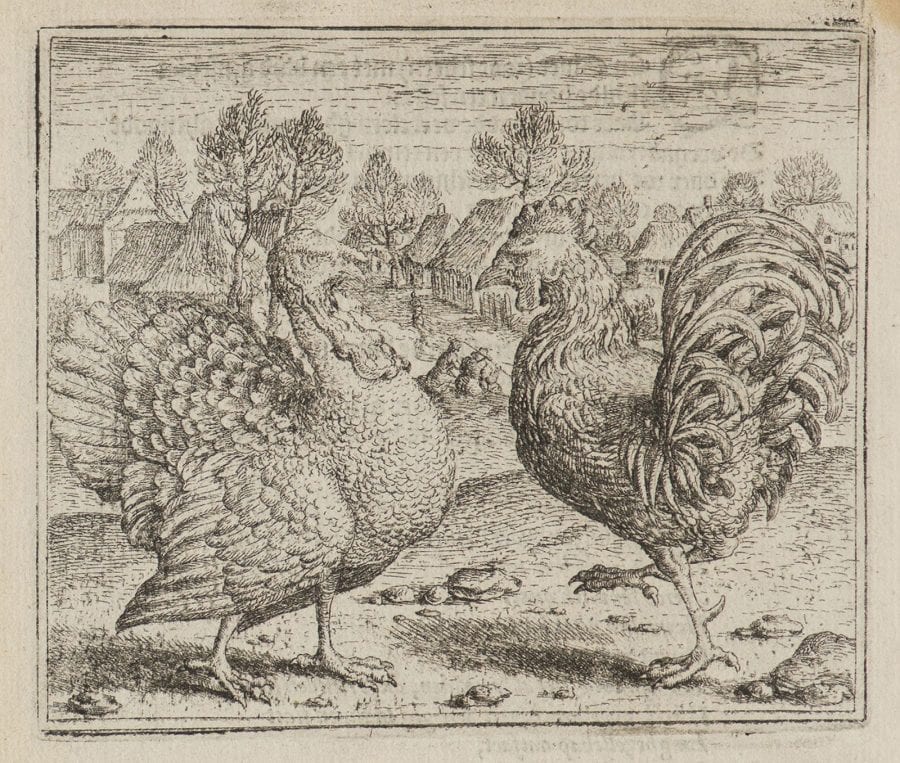
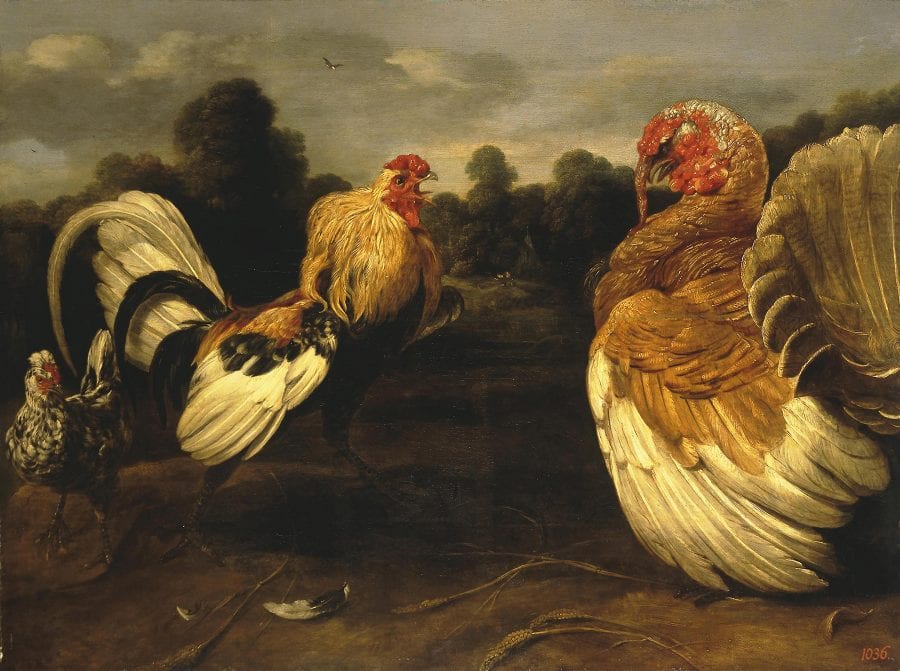
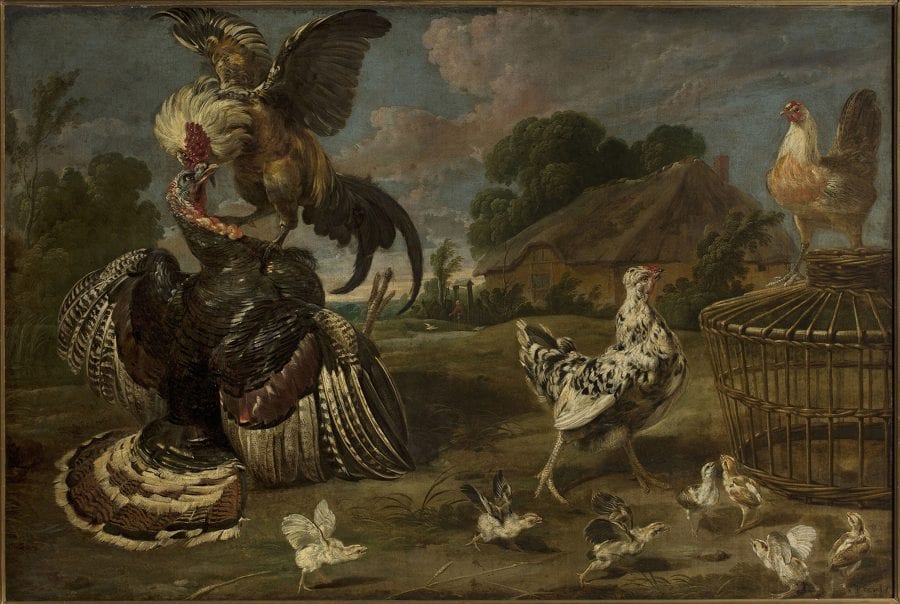
Despite the cock’s dominant position in Fyt’s Brussels painting, the moralizations in Flemish fable books make clear that he is the villain of the fable. His selfish attitude is interpreted in these texts as a denunciation of those who are intolerant toward strangers who come to live among them. In Vondel’s moralization, this extends to a condemnation of “savage” xenophobic attitudes:
In the end the Turkey saw that the Dutch cock would leave him neither rest nor peace: so he removed himself completely from all kinds of strife, and chose to seek his daily bread in peace in other places. “Many peoples are so wild, so savage and hot headed, that the poor stranger may not dwell with them. Even though they have won a land for their own needs, they would even begrudge another to live on the very earth itself.”55
De Dene’s original fable had underscored equally strongly the roles of the cock and turkey as, respectively, native dweller and stranger by its designation of the birds as a “Flemish” and a “Turkish” or “foreign” (d’Wytlandtsche) cock—categories that imply difference but also common membership of a wider, overarching type.56 In his moralization, de Dene, like Vondel, takes the xenophobic to task: “Likewise, some take the view that a foreign visitor should accept duress just to be allowed to live; they mumble jealously among themselves, not resting until they have driven him out.”57
The error of judgment that leads the proud cock to commit violence is thus not a mistaken characterization of its victim as entirely “Other,” an animal deserving his scorn because it is different from him. The cock’s recognition of the turkey as a potential competitor in the mating game also acknowledges similarity between them. This is a point made explicitly in the opening line of Arthur Golding’s contemporaneous English version of the fable: “A DUNGHILL Cock being of a proud courage, stood so immoderately in his own conceit that he disdained all fowls of his own kind.”58
Introduced into the Netherlands in the sixteenth century from the New World, the turkey had initially been viewed as an exotic, with the matter of its species relationship to the cock stimulating much debate. Initial discussions of it by early modern ornithologists are a morass of confusion, with it being mistaken for the peacock, guinea fowl, and varieties of poultry from the Indian subcontinent, among other birds. However, as Lise Lotte Möller has shown in her survey of visual depictions of the turkey, by the beginning of the seventeenth century its presence in Europe was well established.59 Seen from the point of view of up-to-date natural history, therefore, the cock’s error is a double one: he not only perpetrates illegitimate violence but does so against an animal to which he is in some sense related and who has a legitimate claim to share his dwelling place.60
Questions about the difference between closely related kin had particular relevance to the Low Countries, a dwelling place that was also an unstable, contested territory. De Dene’s new fable about two birds of the same kind but different “nationalities” would have carried multifaceted political resonances for readers in the southern Netherlands living through the 1560s and later decades, when the question of who should be able to inhabit the region had become divisive.61 The fable might have been taken to refer to the ongoing military conflict with the northern provinces, which were previously firmly under the control of the Spanish Habsburg empire, or to the often fractious relationship between the Flemish themselves and their Spanish overlords. Given the continuing popularity of fable books, Fyt’s later painting is likely to have retained much of the fable’s original political charge. Although in 1648 the seven northern provinces were officially recognized by Spain as a separate geopolitical entity, inhabitants of the whole region, particularly those in towns and cities situated along the shifting border between north and south, continued to suffer the effects of military conflict throughout much of the seventeenth century. By the middle decades of the century, too, the opportunities and risks associated with dealing with the Turk, or foreigner, and with the New World (still regarded at this point as the turkey’s place of origin) were at the forefront of national attention.
While individual beholders might have identified the birds in the Brussels painting with one or another of these forces, fundamentally the politics of the work has more to do with how it negotiates a deeper, longstanding anxiety in the culture about how to integrate and transact with the Other (however defined) without a fatal loss of one’s own power, identity, or physical territory. Fyt’s intensely vitalized rendering of the opposing factions in the painting as battling, rapidly moving bodies allows the uncertainties that surrounded this issue to manifest themselves visually. For example, the tension between the birds’ current hostility and their underlying kinship is registered in the way that their fighting forms are echoed in the two gnarled trees growing around each other behind them—an image of separateness that also hints at the possibility of imminent reunion or future coexistence. Calling to mind the idea in zoopoetics that the creature and its habitat exist in continuous interchange, this visual repetition also collapses the boundary between the birds’ desperate struggle and the barren environment they occupy, linking the problem of intolerance to its deadening impact on the homeland.
The painting offers a counterpoint to this negative vision of internecine violence, although its inclusion is subtle and—in a parallel to the Gallinero—requires close attention to be noticed. The structure attached by a post to the roof of the farmhouse in the far distance is a dovecote. Discernible as white marks that stand out against the building behind them, several doves can be seen (fig. 12). Breeding these birds was a pastime of the affluent; as such, the inclusion of the dovecote identifies the territory in the background as a wealthy Flemish estate. However, when taken together with the fight in the foreground, the signification of the dove as a herald of peace, via its association with the Holy Spirit, also comes into play.

The inclusion of the dovecote sharpens the division between the foreground and background zones of the painting. A traditional humanistic reading of the work would tend to map this pictorial splitting onto an anthropocentric hierarchy, with the background interpreted as the space of the civilized human being (seen as the antithesis of the cock because, as the dovecote indicates, he is willing to share his dwelling place with the Other), which is then juxtaposed with the animal violence occurring in the foreground. In calling attention to the embodied character of the human gaze, zoopoetics can productively complicate such a reading. It asks that we also take account of the painting’s capacity to generate an excited, engrossed reaction to the spectacle of violence, belying the view that incivility is restricted to the animal Other. In place of a cohesive moral subject that rejects violence, zoopoetics points to a more equivocal construction of human nature in the work—one divided between the pacific, elite subjectivity in the background and a “lower,” more voyeuristic mode of looking produced by the work’s close viewpoint, which brings the beholder near enough to the struggle to see that the cock has seized the turkey by its snood. Like the depictions of bird fighting to which it is related, the painting negotiates the ambivalences that attached to witnessing avian violence, which in the period had less to do with concerns over animal suffering than with acknowledging the savage or animalistic side of human nature and its potentially disastrous social effects.
Conclusion
The rise in northern Europe of fable pictures that pay unprecedented attention to the variety and complexity of birds’ bodies, temperaments, and abilities, first in printed books like the Warachtige fabulen and later in the easel format, took place at a moment when images had begun to play an increasingly vital role in the production of knowledge about animals and the nonhuman environment. In an era before the disciplinary divide between factually based and imaginative ways of understanding the material world had become fully entrenched, fable texts and images aligned new discoveries about nature with bodies of classical, scholastic, and humanistic knowledge that were still widely regarded as authoritative. In this essay, I have argued that Fyt’s fable painting can be understood usefully within this framework. In the works examined here, the description of nature does not take precedence over the engagement with fable. Rather, the narrative, allegorical, lifelike, and “factual” aspects of the image exist in an interplay that resists being disaggregated. The Gallinero is centrally concerned with a form of visual acuity, linked to the diligent, scrupulous cock, that is presented as worthy of emulation—something that plays against the emphasis in many versions of the fable on the difference between ignorant animal and knowing human. Challenging the beholder differently, the Brussels painting asks us to attend to a spectacle of violence that places side by side harmful aspects of animal and human nature, in particular their capacity for violence and intolerance. Both works evade singular categorization as either animal paintings or fable paintings, and they operate across what would later become the “two cultures” of art and science at a moment before their definitive separation.
